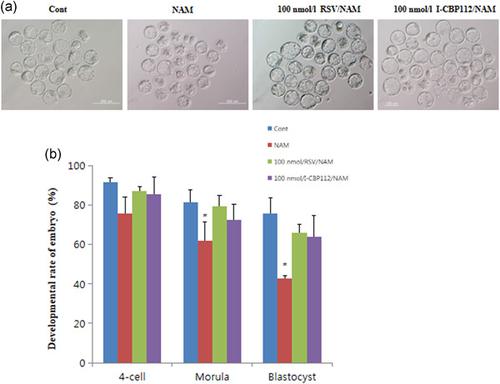当前位置:
X-MOL 学术
›
Mol. Reprod. Dev.
›
论文详情
Our official English website, www.x-mol.net, welcomes your feedback! (Note: you will need to create a separate account there.)
Nicotinamide-induced mouse embryo developmental defect rescued by resveratrol and I-CBP112.
Molecular Reproduction and Development ( IF 2.5 ) Pub Date : 2020-08-20 , DOI: 10.1002/mrd.23405 Yu-Guo Yuan 1, 2, 3 , Jia-Lin Wang 1 , Ayman Mesalam 4 , Ling Li 1 , Yun-Jung Choi 3 , Abu Musa Md Talimur Reza 5 , Dongjie Zhou 3 , Li Chen 1 , Chen Qian 1
Molecular Reproduction and Development ( IF 2.5 ) Pub Date : 2020-08-20 , DOI: 10.1002/mrd.23405 Yu-Guo Yuan 1, 2, 3 , Jia-Lin Wang 1 , Ayman Mesalam 4 , Ling Li 1 , Yun-Jung Choi 3 , Abu Musa Md Talimur Reza 5 , Dongjie Zhou 3 , Li Chen 1 , Chen Qian 1
Affiliation

|
Cell cycle of mouse embryo could be delayed by nicotinamide (NAM). Histone H3 lysine 56 (H3K56ac) acetylation plays an important role in mammalian genomic stability and the function of this modification in mouse embryos is not known. Hence, we designed to study the effects of NAM‐induced oxidative stress on the developmental ability of mouse embryos, on the acetylation of H3K56ac and the possible functions of this modification related to mouse embryo development. Treatment with NAM (10, 20, or 40 mmol/L for 24 or 48 hr) during in vitro culture significantly decreased developmental rate of blastocyst (24 hr: 90.2 vs. 81.2, 43.2, and 18.2, with p > .05, p < .01, respectively; 48 hr: 89.3 vs. 53.2%, 12.1%, and 0% with p < .05, respectively). NAM treatment (20 mmol/L) for 6 and 31 hr resulted in increased intracellular reactive oxygen species levels in two‐cell embryos, and apoptotic cell numbers in blastocysts. Resveratrol (RSV) and I‐CBP112 rescued the 20 mmol/L NAM‐induced embryo developmental defects. RSV and I‐CBP112 increased the level of Sirt1 and decreased the level of H3K56ac induced by NAM in two‐cell embryos (p < .05). These data suggest that NAM treatment decreases the expression of Sirt1, which induces high levels of H3K56 acetylation that may be involved in oxidative stress‐induced mouse embryo defects, which can be rescued by RSV and I‐CBP112.
中文翻译:

白藜芦醇和I-CBP112挽救了烟酰胺诱导的小鼠胚胎发育缺陷。
烟酰胺(NAM)可以延缓小鼠胚胎的细胞周期。组蛋白H3赖氨酸56(H3K56ac)乙酰化在哺乳动物基因组稳定性中起重要作用,而这种修饰在小鼠胚胎中的功能尚不清楚。因此,我们设计了研究NAM诱导的氧化应激对小鼠胚胎发育能力,H3K56ac乙酰化以及这种修饰可能与小鼠胚胎发育有关的功能的影响。在体外培养过程中用NAM(10、20或40 mmol / L进行24或48小时)处理可显着降低胚泡的发育速度(24小时:90.2 vs. 81.2、43.2和18.2,p > .05,p 分别<.01; 48小时:89.3 vs. 53.2%,12.1%和0%,p 分别<.05)。NAM(20 mmol / L)处理6小时和31小时会导致两细胞胚胎的细胞内活性氧水平增加,胚泡中的凋亡细胞数增加。白藜芦醇(RSV)和I-CBP112挽救了20 mmol / L NAM诱导的胚胎发育缺陷。RSV和I-CBP112增加了NAM诱导的两细胞胚胎中Sirt1的水平并降低了H3K56ac的水平(p <.05)。这些数据表明,NAM处理可降低Sirt1的表达,从而引起高水平的H3K56乙酰化,这可能与氧化应激诱导的小鼠胚胎缺损有关,可通过RSV和I-CBP112予以挽救。
更新日期:2020-10-07
中文翻译:

白藜芦醇和I-CBP112挽救了烟酰胺诱导的小鼠胚胎发育缺陷。
烟酰胺(NAM)可以延缓小鼠胚胎的细胞周期。组蛋白H3赖氨酸56(H3K56ac)乙酰化在哺乳动物基因组稳定性中起重要作用,而这种修饰在小鼠胚胎中的功能尚不清楚。因此,我们设计了研究NAM诱导的氧化应激对小鼠胚胎发育能力,H3K56ac乙酰化以及这种修饰可能与小鼠胚胎发育有关的功能的影响。在体外培养过程中用NAM(10、20或40 mmol / L进行24或48小时)处理可显着降低胚泡的发育速度(24小时:90.2 vs. 81.2、43.2和18.2,p > .05,p 分别<.01; 48小时:89.3 vs. 53.2%,12.1%和0%,p 分别<.05)。NAM(20 mmol / L)处理6小时和31小时会导致两细胞胚胎的细胞内活性氧水平增加,胚泡中的凋亡细胞数增加。白藜芦醇(RSV)和I-CBP112挽救了20 mmol / L NAM诱导的胚胎发育缺陷。RSV和I-CBP112增加了NAM诱导的两细胞胚胎中Sirt1的水平并降低了H3K56ac的水平(p <.05)。这些数据表明,NAM处理可降低Sirt1的表达,从而引起高水平的H3K56乙酰化,这可能与氧化应激诱导的小鼠胚胎缺损有关,可通过RSV和I-CBP112予以挽救。


























 京公网安备 11010802027423号
京公网安备 11010802027423号